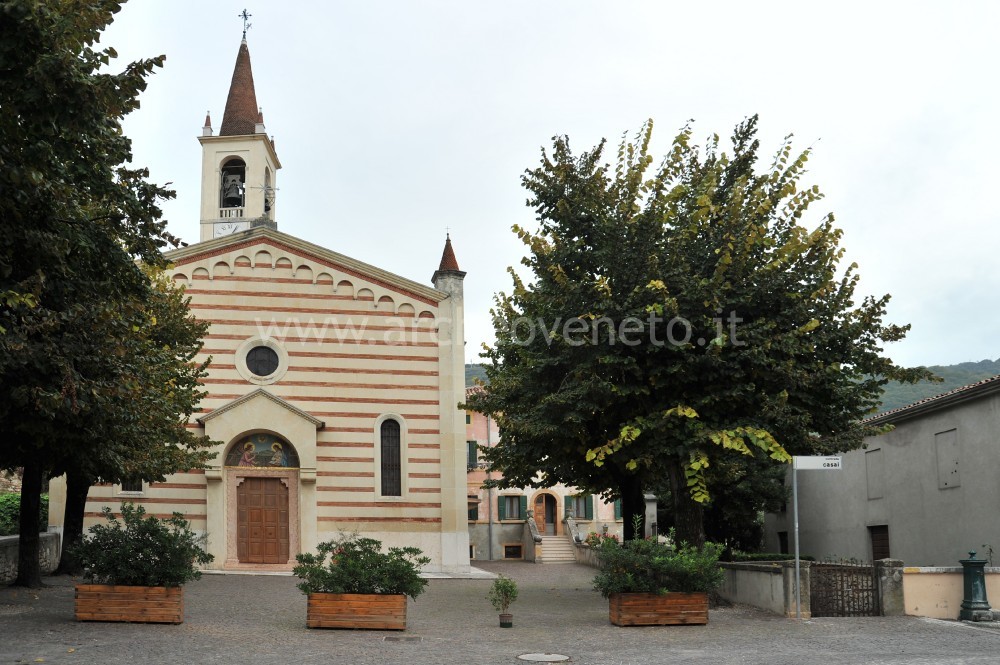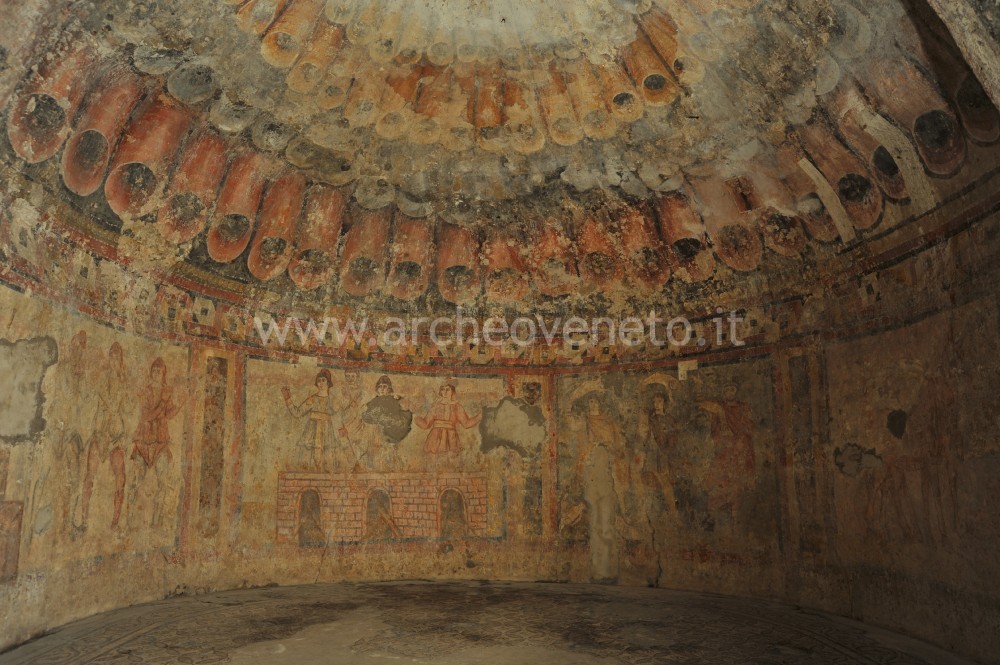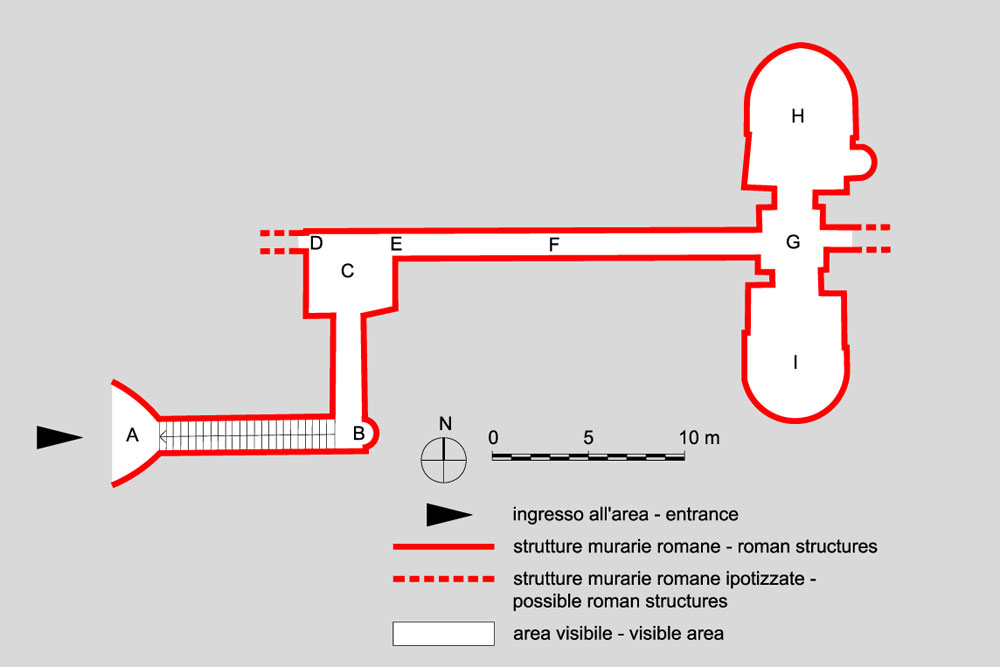|
|
File
Roman underground aqueduct and early Christian cults area in the locality of “Santa Maria in Stelle” – Verona
|
| Via Santa Maria in Stelle 1, near the church of the "Assunta" – 37100 Verona (VR)
|
  |
|
Summary

The hypogeum of “Santa Maria in Stelle” is an underground structure that was built in the III century A.D. It is difficult to understand, but it is thought to have been a funerary area, and aqueduct or a “nymphaeum” that caught the water from an underground spring. From IV century A.D. the hypogeum was arranged into a chapel for Christian cults and as such it was used until the XII century.
History of research
The hypogeum of “Santa Maria in Stelle” is also known thanks to the Gaetano Cristofali’s drawings at the end of the eighteenth century. Restoration and maintenance works allowed its current use.
Urban and geographical context
The hypogeum is located about ten kilometres northeast of Verona, at the beginning of the Valpantena valley and nearby the village of “Santa Maria in Stelle”.
Chronology
III – VI A.D. and Medieval times |

 The hypogeum of “Santa Maria in Stelle” is located about 4 metres deep, below the parish church of the “Assunta”. It was built in the III century A.D., probably as a a funerary area for Publius Pomponius Cornelianus and for his family, as it is mentioned by the inscription on the architrave above the entrance to the long internal corridor. It is also possible that the hypogeum was an aqueduct or a “nymphaeum” for the Nymphs the landowner worshipped. From the IV century A.D. the structure became a chapel for Christian cults and a burying place and it kept on being used at least until the XII century A.D., when pope Urban III went to visit the place (1187 A.D.). The hypogeum of “Santa Maria in Stelle” is located about 4 metres deep, below the parish church of the “Assunta”. It was built in the III century A.D., probably as a a funerary area for Publius Pomponius Cornelianus and for his family, as it is mentioned by the inscription on the architrave above the entrance to the long internal corridor. It is also possible that the hypogeum was an aqueduct or a “nymphaeum” for the Nymphs the landowner worshipped. From the IV century A.D. the structure became a chapel for Christian cults and a burying place and it kept on being used at least until the XII century A.D., when pope Urban III went to visit the place (1187 A.D.).
The access to the hypogeum is through some stairs (A), at the end of which there is a niche with the statue of a man wearing a toga (B). The man is most likely Publius Pomponius Cornelianus, who lived in the first half of the III century A.D. and who was well known in the Verona territory for having held public positions as an imperial officer. The statue is made of three distinct parts: the head, the body and the feet up to the ankles. The latter are believed to be the only original part of the statue.
Then we enter a squared room (C) where we find a water tunnel (D) and an architraved opening (E) with the inscription recalling the person who built the hypogeum, Cornelianus, with his wife Julia Magia and his children Coriolanus and Magianus. Through the architrave door we move into a barrel vaulted corridor (F) that follows the natural path of the water and that leads to the water spring. This corridor is about 100 metres long and it is divided by wells into four parts. The first two parts are paved with stone slabs, whereas the following ones are more narrow and uncomfortable, with the water running in an open logline in the middle of the gallery. In the spring well the water is collected in a semicircular basin excavated in the rock, where the soil deposits. At about one quarter of the corridor there is a cross-shaped hall (G) with two large mirror cells (H, I) with apse and semi-domed ceiling. These cells were added between the IV and the VIII century A.D. when the hypogeum became a religious chapel. They are paved with mosaics and have fresco paintings displaying religious scenes, of which those in room H are the best preserved. The themes of the paintings, such as the slaughter of the innocents, the three young men in the furnace, the three young men in front of Nebuchadnezzar, Christ among the apostolic college, are drawn from the Old and New Testament and are among the most precious series of scenes in northern Italy.
|

Admission: Solo su prenotazione
Visitability: Interno
Ticket: No
 School access School access
Upon reservation
Recommended tour time (minutes): 60
 Information boards Information boards
| Venturi G. 1811, Descrizione di un sotterraneo a Santa Maria delle Stelle, Verona. |
| Orti Manara G. 1848, Di un antico monumento dei tempi romani che trovasi nella terra delle Stelle presso Verona, Verona. |
| Pighi A. 1903, S. Maria in Stelle e il così detto Pantheon. Brevi cenni storici, Legnago. |
| Forlati Tamaro B. 1962, L’ipogeo di Santa Maria in Stelle (Verona), in Atti dell’Ottavo congresso di studi sull’arte dell’alto Medioevo (Verona, 1959), Milano, pp. 245-259. |
| Dorigo W. 1968, L’ipogeo di Santa Maria in Stelle in Valpantena, in Saggi e Memorie di storia dell’arte, 6, Firenze. |
| Dalla Barba Brusin D. 1977, Una probabile "aedes catechizandorum" nell’ipogeo di S. Maria in Stelle, in Aquileia Nostra, 48, pp. 258-270. |
| Mangani E., Rebecchi F., Strazzulla M.J. 1981, Emilia, Venezie (Guide Archeologiche Laterza), Bari, pp. 181-182. |
| Franzoni L. 1987, Il territorio veronese, in Il Veneto nell’età romana, II, a cura di Cavalieri Manasse G., Verona, pp. 59-105. |
| Fiorio Tedone C. 1989, Il territorio veronese. Santa Maria in Stelle in Valpantena, in Il Veneto nel Medioevo. Dalla “Venetia” alla Marca Veronese, II, a cura di Castagnetti A., Varanini G.M., Verona, pp. 146-151. |
| Franzoni L. 1991, La presenza romana. Il Ninfeo di Santa Maria in Stelle, in Grezzana e la Valpantena, a cura di Turri E., Caselle di Sommacampagna, pp. 84-103. |
| Veneto e Friuli-Venezia Giulia (Guide Archeologiche Preistoria e Protostoria in Italia) 1996, a cura di Aspes A., Fasani L., Forlì, pp. 90-97. |
| Archeologia a Verona 2000, a cura di Bolla M., Milano, pp. 98-101. |
| Trentin M., Hadjikyriakos I. 2005, L’ipogeo di Santa Maria in Stelle: proposte per una nuova lettura cronologica, in Archeologia dell’Architettura, X, pp. 67-87. |
| Antolini L. 2006, L’ipogeo di Santa Maria in Stelle: guida storico-artistica, Verona. |
| David M., Maccani C. 2007, I pavimenti musivi dell’ipogeo tardoantico di Santa Maria in Stelle (Verona). Problemi di documentazione e interpretazione, in Atti del XII Colloquio AISCOM (Padova-Brescia, 14-17 febbraio 2006), a cura di C. Angelelli, A. Paribeni, Tivoli. |
| Bonetto J. 2009, Veneto (Archeologia delle Regioni d’Italia), Roma, pp. 451-452. |
|

